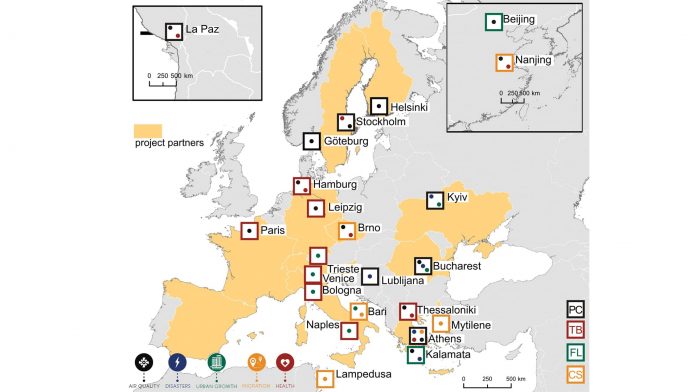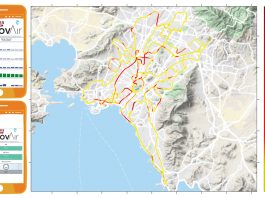Dr Evangelos Gerasopoulos introduces the SMURBS project, which harnesses Earth observation in the service of ‘SMart URBan Solutions for air quality, disasters and city growth’.
According to the UN’s ‘World Urbanization Prospects: 2014 Revision’, in today’s increasingly global and interconnected world, over half of the world’s population lives in urban areas, the continuing urbanisation is projected to add 2.5 billion to the urban population by 2050, and the world population living in cities is expected to increase to 66%. Under these circumstances, sustainable development challenges will increasingly concentrate in cities. It is here that the SMURBS project comes in.
Under the umbrella of the ERA-PLANET Network, the SMURBS project aims at setting the stage for the integration of the still fragmented Earth observation (EO) resources to promote and co-ordinate the ‘smart city’ concept into a European network of cities, serving the need for a common approach to enhance environmental and societal resilience to specific pressures.
What is the ERA-PLANET Network?
ERA-PLANET, the ‘European Network for Observing our Changing Planet’ (www.era-planet.eu), is comprised of 36 partner organisations from 14 European countries, aiming at strengthening the European Research Area (ERA) in the domain of EO, in coherence with the European participation in the Group on Earth Observations (GEO) and the Copernicus programme of the European Union. ERA-PLANET is an ERANET Co-fund action under the EU Horizon 2020 framework programme (Grant Agreement No. 689443). From its transnational call for collaborative projects in four distinct topics, SMURBS was the winning project under the strand ‘Smart Cities and Resilient Societies’.
Policy framework
The project actions pursue the efficient transformation of EO into information, services, and decision-making tools for citizens and local governments. The vision is to deliver and demonstrate the use of EO in support of the GEO’s Societal Benefit Areas of ‘Sustainable Urban Development’, ‘Public Health Surveillance’ and ‘Disaster Resilience’. Furthermore, the SMURBS project extracts ‘smart’ concepts incorporated in the
UN-Habitat New Urban Agenda and the European Union’s Urban Agenda, and enriches the currently poor knowledge base of EO-based urban essential variables (EVs) that are critical for monitoring the targets under the UN’s Sustainable Development Goal 11 ‘Sustainable Cities and Communities’. Alignment with national and city agendas is, by all means, an overarching imperative.
The concept
SMURBS brings together different EO platforms, namely in situ networks, satellites, state-of-the-art models, and new technologies (e.g. UAVs, smart sensors), while also engaging citizens in collecting and sharing data. Its partners refocus their high degree of EO expertise on the urban scale and set the stage to exploit synergies between the various EO resources. The project maps ‘what is already out there’ and ‘what the users want’ to stimulate strategic planning and decision making by key stakeholders. The development of a portfolio of smart urban solutions is the culmination of these efforts, entailing tailored, tested, and interdisciplinary products and services. The solutions will be deployed in pilot-lighthouse cities, showcasing effectiveness and benefits, while replication potential will be explored in follower cities.
Emphasis is on real user needs and co-design
The long-term sustainability of any solution necessitates the early and meaningful engagement of stakeholders. Solutions should be addressing real needs in a practical way; thus, SMURBS has undertaken a number of relevant activities to meet and discuss with decision makers and citizens. To pursue this:
- A targeted online survey was launched (February 2018) to collect current status and user needs from distinct stakeholder groups (i.e. public authorities, academia, industry);
- A stakeholder workshop was held in Hamburg, Germany (27-28 March 2018), where specifications on actual needs were put on the table in a more coherent manner;
- The first of a series of citizen workshops was held – ‘scientific café’-style – in the follower city of Kalamata, Greece (16 April 2018); and
- A series of dedicated interviews with high-level decision makers is underway, aiming primarily at the co-design of solutions.
The input received is well-distributed, both stakeholder- and geographical-wise. Public authorities and academia, from 18 countries and 32 cities, are the main contributors (80%), while the rest is shared between NGOs/citizen associations and the EO private sector. Interesting messages include the lack of confidence in one’s city resilience on the pressures addressed by SMURBS. Moderate to limited awareness of large European and global initiatives is also registered, such as the GEO, Copernicus and FAIR. The timeliness and necessity of the SMURBS project is also reflected in the declared interest of the responders, not only to stay passively informed but also to get actively involved in specific activities. Furthermore, almost 200 institutions were indicated as potentially interested in SMURBS, constituting a resounding impact of the project’s outcomes.
Highlighted outcomes
- Air quality and health – SMURBS unfolds the full range of technologically available methods for the next generation of urban monitoring capacities and high-resolution city-scale modelling. The seamless bridging of regulatory networks with IoT/smart sensors and supersites is the direction that SMURBS engages in to deliver, inter alia, monitoring of pollutants of emerging importance (e.g. PM1, black carbon) and near real-time source apportionment. New advancements, like the monitoring of the oxidative potential of aerosol in urban environments, in conjunction with supplementary health indicators, will be utilised to delineate cause-effect relations. Exploitation and contribution of Copernicus Atmosphere Monitoring Services will further support the AQ objectives;
- Disasters – SMURBS addresses natural and anthropogenic disasters affecting cities or peri‐urban neighborhoods, covering all phases of the disaster management cycle. The 2014 Copernicus Masters-awarded application for real-time fire monitoring, ‘Firehub’, as well as the Floods Monitoring Service, ‘Floodhub’, will be further adjusted to the particularities of the urban landscape, while the challenging, but highly rewarding, incorporation of crowd-sourcing in the service chain is underway;
- Urban growth – SMURBS exploits the capacity provided by the Copernicus Land Monitoring Service and the Sentinel-2 mission, as well as the availability of high and very high resolution imagery to define updated urbanisation indicators, to adopt state-of-the-art classification schemes, and to develop urban metrics for efficient city management methods, addressing soil sealing and the urban sprawl phenomenon; and
- Migration – the SMURBS project explores a novel field: EO supporting certain aspects of the European migrant crisis. The vulnerability of refugees’ hot spots and hosting campuses to natural and manmade disasters will be at the epicentre of SMURBS’s efforts, contributing to the current lack of concrete criteria for location appropriateness.
The vision
The integration of state-of-the-art EO with traditional smart city methods is the distinguishing characteristic of SMURBS, whose vision is to create a constellation of European and overseas cities, where EO will be exploited as a major resource for fact-based decision making and informed citizens. A group of cities, at different stages on the smart city journey, of varying sizes, geographies and environmental pressures, is selected, while the list dynamically expands via the project’s networking activities. SMURBS’s driving goal is to eventually reinforce European leadership within the GEO by contributing decisively to the implementation of the GEO Strategic Plan (2016-2025), capitalising on EO investments, at the same time training and preparing a new generation of smart citizens.
Dr Evangelos Gerasopoulos
Research Director
National Observatory of Athens (NOA)
+30 210 8109124
egera@noa.gr




